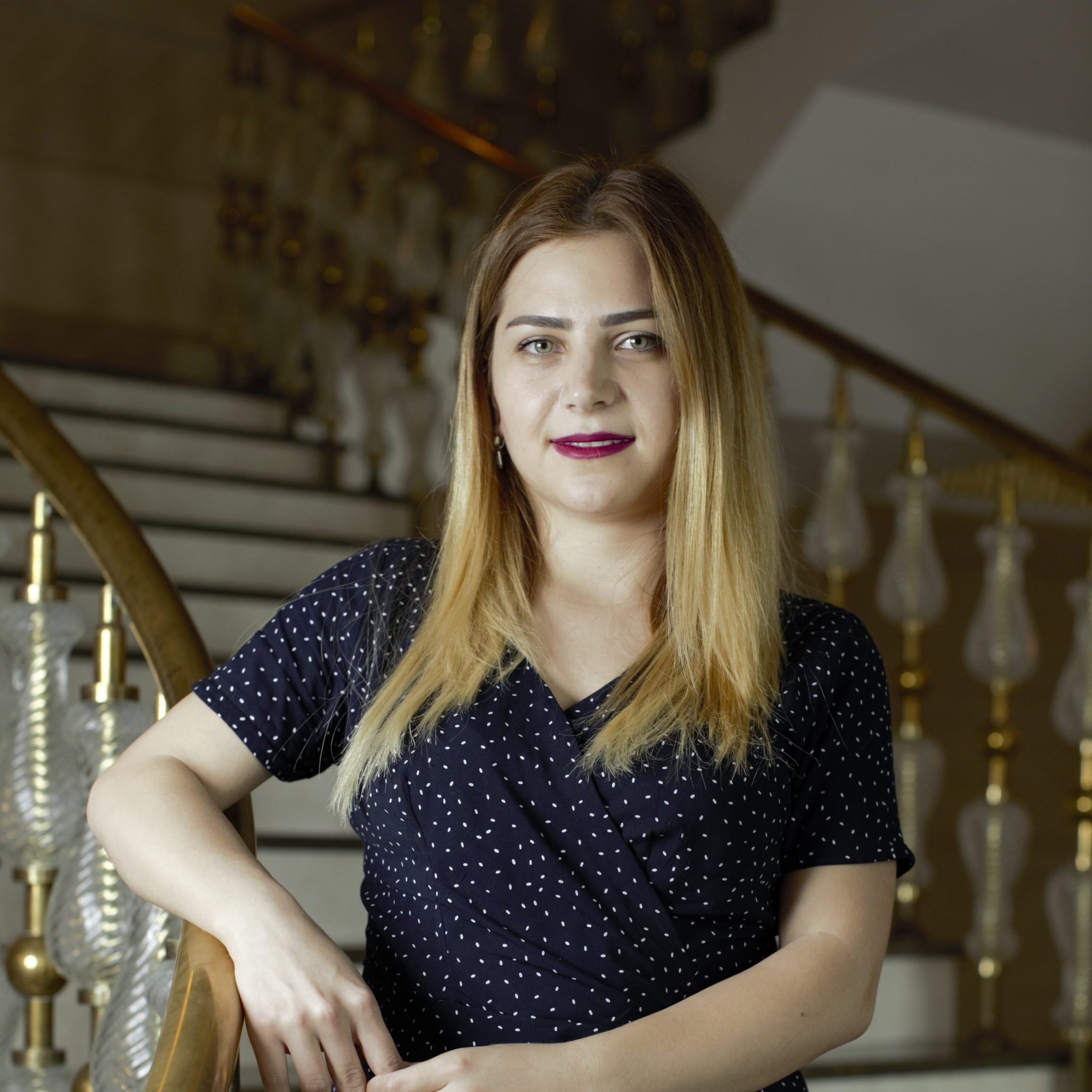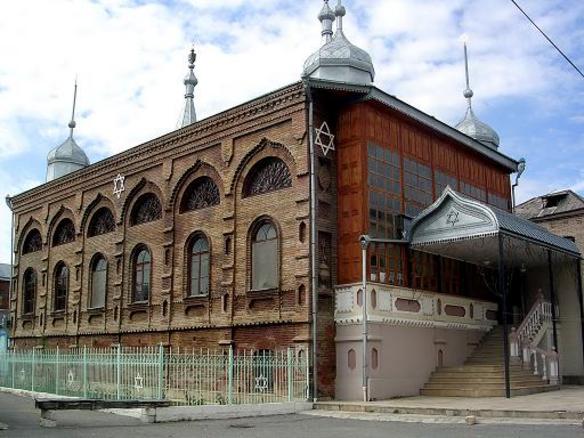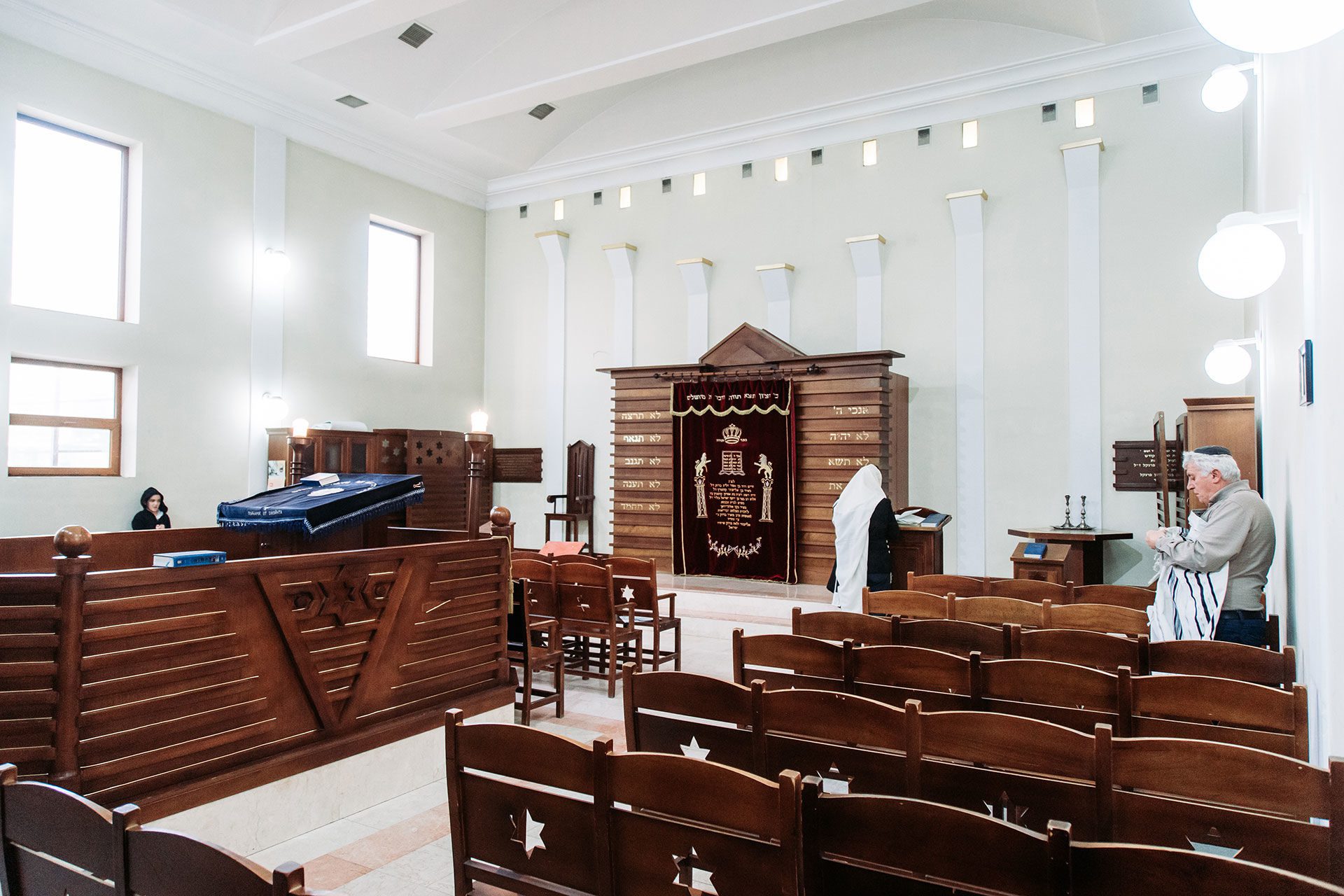Introduction
Jewish heritage in Azerbaijan is represented by several monuments in Baku, Quba, Oghuz, Ismayilli, and other parts of Azerbaijan. Many ruins of ancient synagogues have been found in different parts of the country.
Jews have lived in Azerbaijan for centuries, but their arrival in Baku dates to the 1830s. Later, the community grew rapidly during the Oil Boom, which enticed diverse people to the city in search of work and wealth.
Currently, there are six synagogues in Azerbaijan: two in Baku, two in Quba, and two in Oghuz. A new Jewish synagogue, which became one of the biggest synagogues in Europe opened in Baku on March 9, 2003. The main Jewish heritage sites that operate to date in Azerbaijan are the following: Synagogue of Ashkenazi Jews, Synagogue of Mountain Jews, “Alti Gumbaz” Synagogue Gilaki Synagogue, “Ashagi Mahalla” Synagogue, “Yukhari Mahalla” Synagogue, The Museum of Mountain Jews.
Azerbaijan has attracted various tribes and peoples since ancient times
Some passed through these territories, while others stayed and settled. Thus, more than 20 national minorities settled and still live in peace on Azerbaijani lands. Among them are Jews, who have maintained their own material and spiritual culture, including religion, language, mentality and self-consciousness throughout years. It is believed that Jews have been living in the territories of Azerbaijan since 5th century BC.
There are several theories explaining the reasons behind their settlement in Azerbaijan and the exact path that they took before settling. According to the traditional views, the indigenous Jews arrived on the territory of Azerbaijan following the destruction of Jerusalem by Nebuchadnezzar, the Babylonian king, in 586 BC. Nebuchadnezzar deported the majority of the population of the ancient Judean kingdom to his northern possessions, which included the territory of modern Azerbaijan. Emperor Cyrus, the founder of the Achaemenid Empire (580-529 BC), brought Jewish settlers into his new empire. After the Persian emperor captured the Babylonian possessions in 539 BC, he decreed the return of the Jews to Jerusalem, but a sizable community of Jewish settlers remained. As a result, a significant Jewish Diaspora formed within the boundaries of the Persian Empire.
Under Shapur I (241-272) the Sassanid authorities allowed Jews to establish their communal institutions and adopt formal leadership by their Head of the Diaspora. Jewish population centers were also found in the Persian Empire´s provinces of Shirvan and Derbent. Important archaeological proof of the Jewish presence in historical Azerbaijan was provided by the discovery of a 6th century synagogue during excavations of Shabran settlement. In the 7th century, Islam was brought to Azerbaijan by the Arab conquests of Persia and the Caucasus. In Azerbaijan, the pace of conversion to Islam was uneven. Southern Azerbaijan became a part of the Umar Caliphate in 639. In northern Azerbaijan, the Albanian kingdom at first became a vassal state of the Caliphate, where the predominantly Zoroastrian, Christian and Jewish populations, as Ahli-Kitaba (Peoples of the Book), were forced to pay non-Muslim Jizya tax, locally known as haraj. The Albanian kingdom rebelled against the Arab imposition, so the new caliph, Usman (644-656), sent Arab armies to convert the local population by force. Jews found the stability provided by the Caliphates appealing. After the collapse of the Caliphate, Quba-Khacmaz province became part of the Shirvanshah Emirate (799-1063) with its capital in Shabran, a town with a significant Jewish population. The Jewish community of Azerbaijan reached the zenith of its influence during the reign of the Mongolian Il-khanids, whose empire stretched from the Caucasus to the Persian Gulf in the 13-15th centuries. Under the dynasty, whose early rulers professed Buddhism, Azerbaijan experienced a period of great religious tolerance and a revival of economic activity. The Buddhist Il-Khans attracted Jews into their higher echelons of civil service and bureaucracy.
After the conversion to Islam of Khan Mahmud Ghazan (1295-1304), an anti-Jewish faction rose to power in the Il-Khanid Empire, which led to a series of Jewish massacres. As a result, many Jewish courtiers converted to Islam, including Rashid al-Din Tabib, the court first vizier, historian and geographer under Khan Mahmud Ghazan. Tabib wrote Jamiat Tavarih (The Collection of Chronicles), a compendium of history and geography, which is considered one of the most comprehensive sources of Oriental historiography in the Persian language. He was killed with the order of a Shariah court in 1318. By the 17th century Jewish villages formed a band of settlements from Derbent to Quba. During the reign of the Shirvanshahs, the majority of the Jewish population of Azerbaijan concentrated in Quba-Khachmaz Khanate. After several waves of anti-Jewish persecution and forced conversions of Nadir Shah in the 16-17th centuries, large groups of Jewish population from Gilan and Tehran of the Persian Empire moved the Quba-Khacmaz Khanate. During the struggle for possession of northern Azerbaijan between the Ottoman and Persian Empires, indigenous Jews experienced persecution and destruction of their property by the invading armies. Shortly thereafter, a significant portion of Persian (Tat) speaking Jews, as well as from Dagestan and other Azerbaijani khanates migrated to the Khanate of Quba during the rule of Hussein Ali Khan. The Jewish community experienced a true renaissance under the rule of Fatali Khan of Quba (1758-89), who provided protection to the Jewish community. Jewish artisans, silk weavers, gardeners and merchants contributed significantly to the economy of the khanate under his rule. Fatali Khan left an indelible mark of gratitude in the memory of Azerbaijani Jews so that his name is commemorated in the name of the main street of Qirmizi Qasaba. Today, Azerbaijan is still home to many Jews, who are divided into three sub-ethnic groups: Mountain Jews, Ashkenazi and Ebraelis. There is also the village of Privolnoye in Jalilabad, where subbotniks and hers – ethnic Russians who professes Judaism reside. Mountain Jews came to Azerbaijan in the 6th century and remainders of their 7th century synagogue was found near Baku.
The Mountain Jews were banished from Mesopotamia for their attempt of seceding from the Sassanid Empire. In Azerbaijan they chose Baku, Oghuz, Goychay, Quba, Qusar, Ganja, Derbent, Ismayilli, Shabran, Shamakhi and Sheki for their settlements. In the 18th century, the rulers of the Quba Khanate (1747-1806 years), Husseinali Khan (1722-1758) and particularly Fatali Khan (1758-1789) invited the Mountains Jews to their territories and played an important role in their fate in the Caucasus, especially in Azerbaijan and southern Dagestan. This is when the Jewish Sloboda (from 1926 – Krasnaya Sloboda or Qırmızı Qəsəbə) arrived in Quba, the capital of the Khanate. Residents of this first significant settlement of Mountain Jews in Caucasus were engaged in crafts, including carpet weaving, leather making, trade, agriculture, tobacco, and horticulture. The population of Sloboda in 1856 was 3,000 and in 1916 – 8,400. Today it is a cozy settlement with its three-story mansions, Princess home of celebrations, schools, yeshivas and all the attributes of civilized life. It is also known as “Little Jerusalem”. There are two active synagogues here.
The Mountain Jews call themselves Juhur and speak Juhuri a Persian-Jewish language, and use Azerbaijani and Russian as a second language. Another center of Mountain Jews in Azerbaijan is Oghuz, although many have emigrated to Russia and Israel from here after the collapse of the USSR. There are two synagogues here. In Baku, a Jewish Sephardi gymnasium was opened, where Mountain and Georgian Jews studied in the early 20th century. An important center of Jewish culture was the Ilyayev club. Jewish girls were educated at private women’s gymnasiums, colleges, music schools and charities. The first European Jews – Ashkenazi – appeared in Baku in 1810, and formed a community here in 1832. The second wave arrived during World War II. The main spoken language of Ashkenazi Jews for more than a millennium was Yiddish, which is based on the German language and they profess Orthodox Judaism. The Ashkenazi established their primary and secondary Jewish schools, gymnasiums, libraries, yeshivas and private music schools in Baku. Literacy among the Jewish population of Baku was 83% at the time. In addition to the existing synagogues, the Ashkenazi built Central Choral Synagogue in 1910. Among the donors for its construction were the well-known Azerbaijani oil magnates and millionaire oilmen, Z. Tagiyev and M. Naghiyev. The Ashkenazi had their own political party in 1905-1906 and two representatives in the parliament of Azerbaijan Democratic Republic (ADR) in 1918-1920. They had periodic press in their language and several community organizations, clubs and cultural centers. The third group of Jews in Azerbaijan are Kartli Ebraeli, or Georgian Jews. The first Jews arrived in Georgia after the conquest of Jerusalem and the destruction of the First Temple by the Babylonian King Nebuchadnezzar II in 586 B.C. and nearly 700 years after the destruction of the Second Temple in Jerusalem by the Romans in 70. The Ebraelis lived in Akhaltsikh, Batum, Gagra, Gori, Kutaisi, Kulashi, Oni and Tbilisi. They use the Georgian alphabet and speak Georgian and Russian. They use Georgian songs, dances and music. The Ebraelis have also embraced some elements of Georgian cuisine, with the exception of those which are contrary to the rules of Kashrut. At the turn of the 18-19th centuries, the Ebraelis began to move to Azerbaijan and settled in central Baku. Here, they engaged in trade and crafts and were partners of large Russian-Caucasian trading houses, stock exchanges, commercial banks and joint stock companies. The famous Ebraelis of Baku was the philanthropist Elikashvili who played an important role in the education of the Georgian Jews here. Currently, the Ebraeli community in Baku has about 300 members. Once the world’s only all-Jewish town outside Israel, Girmizi Gasaba (Red Settlement) is a settlement of about 3,000 inhabitants in the Guba region whose name was inspired by the characteristic red bricks and tiles used to construct the houses. Much of the local architecture creating the settlement’s unique appearance bears the signature style of a local architect named Hillel Ben-Hayyim, whose richly ornamented houses and synagogues can be seen throughout the village. Most houses have two or more floors and closed courtyards traditionally lived in by families during the seven days of the festival of Sukkot. Only two of the original 13 synagogues still operate, however new development plans include restoring ruined synagogues and establishing a Museum of Mountain Jews. The people of Girmizi Gasaba, who still speak a unique language called Juhuri, have traditionally practised small trades and crafts and played an important role in the development of carpet weaving in Guba. Carpets with different Jewish motifs such as menorah and dragons can still be found in local houses and museums.
Explore the cities on this route

Sharifa Hasanova
Head of Product Development at Azerbaijan Tourism Board
Azerbaijan Tourism Board is a national tourism organization of Azerbaijan for promoting as tourism destination. Our destination brand invites potential travellers to 'take another look' at Azerbaijan's rich culture, ancient heritage, amazing nature and warm hospitality.
As a Product Development Head, Sharifa is in charge for establishment of tourism products development, to regulate and increase tourism experiences and activities, to create good conditions for infrastructure, facilities and services in place for tourism products, to ensure and increase of quality standards of tourism products, to establish tourism destination’s competitiveness and sustainability.
Prior to this, Sharifa was leading Sales and Marketing teams in various hospitality groups in Azerbaijan.







